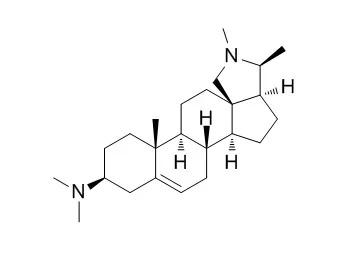| Malaria Journal,2013,11(2):194. |
| Anti-malarial property of steroidal alkaloid conessine isolated from the bark of Holarrhena antidysenterica.[Reference: WebLink] |
In the face of chronic and emerging resistance of parasites to currently available drugs and constant need for new anti-malarials, natural plant products have been the bastion of anti-malarials for thousands of years. Moreover natural plant products and their derivatives have traditionally been a common source of drugs, and represent more than 30% of the current pharmaceutical market. The present study shows evaluation of anti-malarial effects of compound Conessine isolated from plant Holarrhena antidysenterica frequently used against malaria in the Garhwal region of north-west Himalaya.
METHODS AND RESULTS:
In vitro anti-plasmodial activity of compound was assessed using schizont maturation and parasite lactate dehydrogenase (pLDH) assay. Cytotoxic activities of the examined compound were determined on L-6 cells of rat skeletal muscle myoblast. The four-day test for anti-malarial activity against a chloroquine-sensitive Plasmodium berghei NK65 strain in BALB/c mice was used for monitoring in vivo activity of compound. In liver and kidney function test, the activity of alkaline phosphatase (ALP) was examined by p-NPP method, bilirubin by Jendrassik and Grof method. The urea percentage was determined by modified Berthelot method and creatinine by alkaline picrate method in serum of mice using ENZOPAK/CHEMPAK reagent kits.
Compound Conessine showed in vitro anti-plasmodial activity with its IC50 value 1.9 μg/ml and 1.3 μg/ml using schizont maturation and pLDH assay respectively. The compound showed cytotoxity IC50= 14 μg/ml against L6 cells of rat skeletal muscle myoblast. The isolated compound from plant H. antidysenterica significantly reduced parasitaemia (at 10 mg/kg exhibited 88.95% parasite inhibition) in P. berghei-infected mice. Due to slightly toxic nature (cytotoxicity = 14), biochemical analysis (liver and kidney function test) of the serum from mice after administration of Conessine were also observed.
CONCLUSIONS:
The present investigation demonstrates that the compound Conessine exhibited substantial anti-malarial property. The isolated compound could be chemically modified to obtain a more potent chemical entity with improved characteristics against malaria. |
| International Journal of Tropical Insect Science, 1989, 10(2):149-155. |
| Conessine as a larval growth inhibitor, sterilant, and antifeedant from Holarrhena antidysenterica Wall.[Reference: WebLink] |
METHODS AND RESULTS:
Conessine, the steroidal alkaloid of Holarrhena antidysenterica Wall, possesses a wide range of activities against four insect species viz. Aedes aegypti, Dysdercus koenigii, Spodoptera litura and Pieris brassicae. In D. koenigii the compound inhibits the egg hatching of treated adults and nymphs.
CONCLUSIONS:
In Ae. aegypti the larval developmental periods are extended, resulting in a high mortality rate. Such effects are produced at very low dosages of 0.5 to lOppm. Antifeedant activity is observed against larvae of S. litura and P. brassicae at concentrations of 0.005 to 0.2 % of Conessine. |
| Journal of Microbiology & Biotechnology, 2018, 28(4). |
| Conessine treatment reduces dexamethasone-induced muscle atrophy by regulating MuRF1 and atrogin-1 expression[Reference: WebLink] |
Conessine, a steroidal alkaloid, is a potent histamine H3 antagonist with antimalarial activity. We recently reported that Conessine treatment interferes with H2O2-induced cell death by regulating autophagy. However, the cellular signaling pathways involved in Conessine treatment are not fully understood.
METHODS AND RESULTS:
Here, we report that Conessine reduces muscle atrophy by interfering with the expression of atrophy-related ubiquitin ligases MuRF-1 and atrogin-1. Promoter reporter assay revealed that Conessine treatment inhibits FoxO3a-dependent transcription, NF-kappa B-dependent transcription, and p53-dependent transcription. We also showed by quantitative RT-PCR and western blot assays that Conessine treatment reduced dexamethasone-induced expression of MuRF1 and atrogin-1. Finally, we demonstrated that Conessine treatment reduced dexamethasone-induced muscle atrophy using differentiated C2C12 cells.
CONCLUSIONS:
These results collectively suggest that Conessine is potentially useful in the treatment of muscle atrophy. |
| African Journal of Traditional, Complementary, and Alternative Medicines : AJTCAM, 16 Feb 2007, 4(3):352-356 |
| Antibacterial activities of the extracts and conessine from Holarrhena floribunda G. Don. (Apocynaceae).[Reference: WebLink] |
METHODS AND RESULTS:
The methanolic extract and Conessine isolated from the stem bark of Holarrhena floribunda (Hf) were tested for their antibacterial activities on Bacillus: Bacillus cereus, Bacillus subtilis, Bacillus megaterium and Bacillus stearothermophilus using the disc diffusion method. Phytochemical analysis of the crude extract and fractions was also conducted. The inhibition parameters of the crude methanol extract and the total alkaloid fraction were determined using the macrodilution method. The results showed that the crude extract, the total alkaloid fraction and Conessine exhibited a significant antibacterial effect against all the strains studied. The antibacterial effect of Conessine is almost similar to that of chloramphenicol used as reference. The ratio of the minimal bactericidal concentration (MBC) over the minimal inhibitive concentration (MIC) indicates the bactericidal effect of the plant.
CONCLUSIONS:
These results support common use of stem bark of Hf and Conessine isolated from Hf in the treatment of some infectious diseases. |






 Cell. 2018 Jan 11;172(1-2):249-261.e12. doi: 10.1016/j.cell.2017.12.019.IF=36.216(2019)
Cell. 2018 Jan 11;172(1-2):249-261.e12. doi: 10.1016/j.cell.2017.12.019.IF=36.216(2019) Cell Metab. 2020 Mar 3;31(3):534-548.e5. doi: 10.1016/j.cmet.2020.01.002.IF=22.415(2019)
Cell Metab. 2020 Mar 3;31(3):534-548.e5. doi: 10.1016/j.cmet.2020.01.002.IF=22.415(2019) Mol Cell. 2017 Nov 16;68(4):673-685.e6. doi: 10.1016/j.molcel.2017.10.022.IF=14.548(2019)
Mol Cell. 2017 Nov 16;68(4):673-685.e6. doi: 10.1016/j.molcel.2017.10.022.IF=14.548(2019)